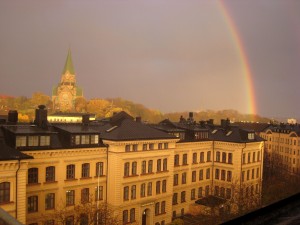Are Creative Countries Happier? More Competitive?

Good place to be creative.
Is it possible to measure a country’s creativity? If so, how does creativity relate to other national characteristics like prosperity, sustainable growth, and happiness?
And, is it time to think less about creative companies and more about creative cities? Perhaps instead of giving tax breaks to attract companies, creative cities should charge a fee to companies that want to capitalize on their creative citizens. But then, how do you create a creative city?
Creativity is joining the traditional trio of land, labor, and capital as one of the key drivers of productivity and growth. In the traditional industrial world, we could use standard measures of land, labor, and capital to identify competitive advantages and disadvantages. But what about creativity? How do we measure countries (and cities) on their creative potential? And how do we develop a competitive advantage in creativity?
These are some of the basic questions the 2015 edition of the Global Creativity Index (GCI). The Martin Prosperity Institute* (MPI) created the index and first published it in 2004, with an expanded version arriving in 2011. (Click here). This year’s index, published over the summer, is the most comprehensive yet.
Can you really measure a country’s or a city’s creativity? MPI argues that there are three elements of creativity and that we already have multiple indexes for each of them. Conveniently, each element begins with a T.
Technology – countries that produce innovative technologies are probably more creative than those that don’t. The GCI uses existing indexes of R&D investment and patent activity to measure the Technology component of creativity.
Talent — the war for talent is certainly raging in creative circles. Old school companies – like Accenture – are buying up design firms – like Fjord – to focus their creative talents on business issues. But how do you measure the creative talent in a country? The GCI uses educational and occupational indexes to identify the creative class.
Tolerance – we know that diversity counts in innovation. Getting different people with different ideas to “collide” is a fundamental innovation strategy. Diversity requires tolerance of other people and of ideas that were not invented here. How to measure tolerance? The GCI uses two proxies: “openness to ethnic and religious minorities and openness to gay and lesbian people”.
MPI researchers create an index for each of the three Ts and then roll them altogether to create one Global Creativity Index. In this year’s ranking, Australia comes in first – it’s the most creative country in the world. Following Australia (in order) are the USA, New Zealand, Canada, Denmark, Finland, Sweden, Iceland, Singapore, the Netherlands.
Does this list sound familiar? It’s quite similar to the list of the happiest countries in the world. (Click here and here). The Nordic countries dominate the happiness rankings. Similarly, Australia, New Zealand, Canada, and the Netherlands are always near the top of happiness indexes.
So, does happiness cause creativity or vice-versa? Are we just measuring the same thing in different ways? Let’s talk about it more in upcoming articles. In the meantime, I hope that you’re both happy and creative.
*MPI is headed by Roger Martin and located at the Rotman School of Management at the University of Toronto. Long-time readers of this website will remember that I’ve written about both Martin and Rotman several times. Martin encouraged Rotman to adopt design thinking as a core element of the curriculum. I’ve also referenced Martin’s efforts to bring critical thinking to business schools. He also advised A.G. Lafley of P&G on strategy. Interesting thinker; interesting school.